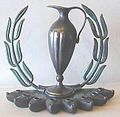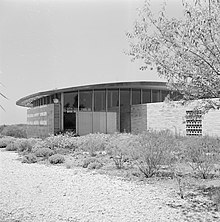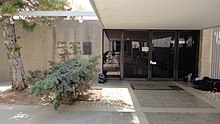Eretz Israel Museum
The Eretz Israel Museum (Hebrew מוּזֵיאוֹן אֶרֶץ יִשְׂרָאֵל Mūsej'ōn Erez Jisra'el, German 'Museum of the Land of Israel') is an archaeological and historical museum in the Ramat Aviv neighborhood of Tel Aviv, Israel.
The museum was founded in 1958 as the Ha'aretz Museum (מוּזֵיאוֹן הָאָרֶץ Mūsej'ōn ha'Arez, German 'Museum of the Land') in the Central European tradition as a national museum. The initiative came from the foundation and estate of the German-born Israeli industrialist Walter Moses (1892-1955). Moses had made the bequest of his archaeological collection, valued at US$1 million, conditional on the establishment of a museum to promote knowledge and exploration of the land through collections, exhibitions, and scholarly publications. Inspired by the Blue and White Jewish Wandering Society and its idealism, he saw knowledge of art and history as a means of fostering a sense of the beauty of the Holy Land and its history in relation to the surrounding cultures, and of forging a true bond between Israel and all cultural peoples.
The museum opened its first exhibition buildings in the north of Tel Aviv on and around the excavation mound Tell Qasile and today houses a collection of archaeological, anthropological and historical exhibits. The master plan for the design of the museum grounds and its buildings was provided by Werner Wittkower (1908-1997), brother of the art historian Rudolf Wittkower. In Wittkower's glass pavilion, the museum initially displayed the glass collection from the estate of Walter Moses, who had immigrated from Germany to Palestine in 1926.
In the following years, the museum was expanded with additional pavilions, each dedicated to a specific theme and collection area: The Kadman Numismatics Pavilion (1962, by Wittkower), the Ethnography and Folklore Pavilion (1963), the Ceramics Pavilion (1966, by Wittkower), the Man and His Works and Activities Center (1982), the Nechushthan Pavilion (1983, Wittkower), the Alexander Pavilion for Postal History and Philately (1998), and the Rothschild Center (2006). A planetarium (also by Wittkower) and the archaeological site of Tell Qasile, in which a site of Philistine foundation was excavated, are also part of the museum. Director Rechavʿam Ze'evi changed the original museum name to its current designation in 1988 during his tenure (1981-1991).
· 
A bronze designed by Maurice Ascalon at a Judaica exhibition at the Eretz Israel Museum.
· 
Amphorae excavated in Tell Qasile
·
Various mailboxes used by the Israel Post over the years at the Alexander Pavilion for Postal History and Philately.

Glass pavilion, 1963

Eretz Israel Museum: View over the 'Center of Man and His Work

Ceramic pavilion with plaque of the donor Walter Moses, 2012
Search within the encyclopedia
